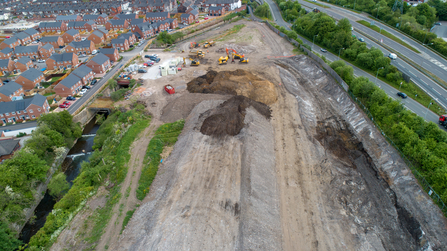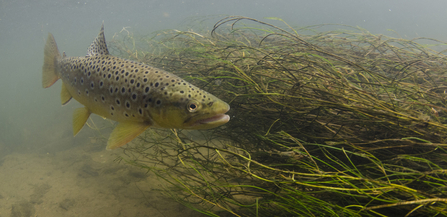|
County nature conservation charity Staffordshire Wildlife Trust led the construction of the new route, which involved the excavating 40,000 tonnes of earth to create a gently meandering course which winds through the site of Stoke City FC’s former Victoria Ground. The new 500-metre river channel will vastly improve this stretch of the Trent for wildlife, offering spawning areas for brown trout, a migration corridor for otters and hunting opportunities for kingfishers. Local residents will also be able to enjoy an attractive nature walk following the construction of a footpath alongside the watercourse which connects to the city centre. Now that the new river channel is complete, landowner St Modwen, who were involved in the design of the new river route, will commence work on the wider development of the site. Once construction is finished, the riverside footpath will be opened to the public. |
Historic moment as River Trent changes course following major conservation scheme at former Stoke City FC ground

|
The project is part of SUNRISE, a major urban conservation initiative focusing on restoring and improving natural habitats at 16 sites around Stoke-on-Trent and Newcastle. This exciting partnership project, totalling £3.6 million worth of improvements across all those sites is primarily funded by the ERDF (European Regional Development Fund) and led by Stoke-on-Trent City Council. Staffordshire Wildlife Trust lead the habitat improvements work, including the historic river diversion, with the support of other partners including the Environment Agency, Newcastle-under-Lyme Borough Council, Groundwork West Midlands and the Wild Trout Trust. |
The project is part of SUNRISE, a major urban conservation initiative focusing on restoring and improving natural habitats at 16 sites around Stoke-on-Trent and Newcastle. This exciting partnership project, totalling £3.6 million worth of improvements across all those sites is primarily funded by the ERDF (European Regional Development Fund) and led by Stoke-on-Trent City Council. Staffordshire Wildlife Trust lead the habitat improvements work, including the historic river diversion, with the support of other partners including the Environment Agency, Newcastle-under-Lyme Borough Council, Groundwork West Midlands and the Wild Trout Trust.
When the city was dominated by heavy industry, the Trent was one of the most polluted rivers in the country and very little wildlife could survive in it. At the turn of the century, a concrete channel was built to confine the river and carry the water out of the city as quickly as possible. Now, the river is once again following a natural path, providing a place where wildlife can thrive and local people can enjoy. This is just the beginning of the recovery of the natural world in Stoke-on-Trent, and lays the foundations for a Nature Recovery Network in the city and the wider county.
|
Natural materials including several thousands of tonnes of gravel and huge tree trunks taken from the site have also been added to the new channel. The gravel will provide potential spawning areas for fish, and the trunks help to prevent erosion in the banks and offer shelter for young fish and aquatic invertebrates on the river bed. Matt Lawrence, project executive for the Environment Agency said: “This is an imaginative and inspiring use of a derelict brownfield site that will benefit the biodiversity of the River Trent as well as offering improved amenities for residents in the city. The project has been some years in the making, but is a great success and everyone involved with it should be very proud to see it reach fruition.” |

|
Councillor Carl Edwards, Stoke-on-Trent City Council cabinet member for housing and the environment, said: “This is a fantastic project and a real landmark for the city. Stoke-on-Trent is one of the greenest cities in the country and we are proud of our open spaces and pleased that this project is creating more opportunities for wildlife to thrive. It is a vast project but attention is being paid to the smallest of details to ensure that we create the best habitat possible. It’ll become a wonderful feature for our city and one that both families and wildlife can enjoy for years to come.” |

|
One of the primary aims of the SUNRISE project is to boost biodiversity and improve ecological connectivity throughout Stoke-on-Trent and Newcastle, utilising the River Trent as a key wildlife corridor. Work being carried out includes river restoration and re-naturalisation of the River Trent and its tributaries, removal of physical barriers such as weirs, wetland creation, grassland improvements, woodland management, and control of invasive species. Healthy natural landscapes are not only beneficial for wildlife, but can provide nature-based solutions to many of the pressing issues facing today’s society, such as increasing resilience to climate change, reducing the impact of flooding and improving physical and mental health. |
To keep up to date with all the conservation work being carried out around Stoke-on-Trent and Newcastle-under-Lyme under SUNRISE, residents can follow Staffordshire Wildlife Trust’s @WildStoke Twitter feed and also sign up to an e-newsletter at www.erdf-sunrise.co.uk/newsletter/
